Influence of Tropical Cyclones and Cold Waves on the Eastern Guangdong Coastal Hydrodynamics: Processes and Mechanisms
Abstract
:1. Introduction
2. Data and Methods
2.1. Data
2.1.1. Study Area
2.1.2. Observation and Satellite Remote Sensing Data
2.1.3. TCs and CWs
2.2. Methods
2.2.1. Data Quality Control
2.2.2. Harmonic Analysis and Axis Transform
2.2.3. Wavelet Analysis
2.2.4. Ekman Volume Transport
3. Results
3.1. Characteristics of Sea Surface Wind and Current Field in the NSCS During Observation
3.2. Seasonal Characteristics of Meteorological and Hydrological Elements in the Eastern Guangdong Coast
3.2.1. Wind, Pressure, and Temperature
3.2.2. Current and Echo Intensity
3.2.3. Bottom-Water Temperature and Residual Water Level
3.3. Variation in Meteorological and Hydrological Elements Caused by TCs and CWs
3.4. Wavelet Transform Analysis
4. Discussion
4.1. Mechanism of the Impact of TCs on Coastal Hydrological Elements
4.2. Mechanism of the Impact of CWs on Coastal Hydrological Elements
4.3. Comparison of the Mechanisms Between TCs and CWs on Coastal Marine Environment
5. Conclusions
Author Contributions
Funding
Institutional Review Board Statement
Informed Consent Statement
Data Availability Statement
Acknowledgments
Conflicts of Interest
References
- Kundzewicz, Z.W. Extreme Weather Events and their Consequences. Pap. Glob. Chang. IGBP 2016, 23, 59–69. [Google Scholar] [CrossRef]
- La Sorte, F.A.; Johnston, A.; Ault, T.R. Global trends in the frequency and duration of temperature extremes. Clim. Chang. 2021, 166, 1. [Google Scholar] [CrossRef]
- Wang, C.; Yao, Y.; Wang, H.; Sun, X.; Zheng, J. The 2020 Summer Floods and 2020/21 Winter Extreme Cold Surges in China and the 2020 Typhoon Season in the Western North Pacific. Adv. Atmos. Sci. 2021, 38, 896–904. [Google Scholar] [CrossRef] [PubMed]
- Wu, X.; He, Q.; Shen, J.; Peng, Z.; Guo, L.; Xie, W.; Lin, J. Different effects between cold front and tropical cyclone on short-term morphodynamics in the Changjiang Delta. J. Mar. Syst. 2024, 243, 103961. [Google Scholar] [CrossRef]
- Li, Y.; Xu, X.; Yin, X.; Fang, J.; Hu, W.; Chen, J. Remote-sensing observations of Typhoon Soulik (2013) forced upwelling and sediment transport enhancement in the northern Taiwan Strait. Int. J. Remote Sens. 2015, 36, 2201–2218. [Google Scholar] [CrossRef]
- Xu, X.; Gao, J.; Shi, Y.; Wu, X.; Lv, J.; Zhang, S.; Liu, S.; Liu, T.; Yang, G. Cross-Front Transport Triggered by Winter Storms Around the Shandong Peninsula, China. Front. Mar. Sci. 2022, 9, 975504. [Google Scholar] [CrossRef]
- Guan, S.; Zhao, W.; Huthnance, J.; Tian, J.; Wang, J. Observed upper ocean response to typhoon Megi (2010) in the Northern South China Sea. J. Geophys. Res. Ocean. 2014, 119, 3134–3157. [Google Scholar] [CrossRef]
- Tang, J.; Wang, Y.P.; Zhu, Q.; Jia, J.; Xiong, J.; Cheng, P.; Wu, H.; Chen, D.; Wu, H. Winter storms induced high suspended sediment concentration along the north offshore seabed of the Changjiang estuary. Estuar. Coast. Shelf Sci. 2019, 228, 106351. [Google Scholar] [CrossRef]
- Wang, T.; Jin, S.; Wang, K. Analysis of the Temporal and Spatial Development of Cold Waves in Fujian Province over the Last 58 Years. J. Phys. Conf. Ser. 2024, 2706, 012071. [Google Scholar] [CrossRef]
- Chen, W.; Tong, Y.; Li, W.; Ding, Y.; Li, J.; Wang, W.; Shi, P. Interannual Variations in the Summer Coastal Upwelling in the Northeastern South China Sea. Remote Sens. 2024, 16, 1282. [Google Scholar] [CrossRef]
- Jin, W.; Liang, C.; Tian, X.; Hu, J.; Ding, T.; Zhou, B.; Chen, X.; Wang, Y. Identifying Oceanic Responses with Validated Satellite Observations after the Passage of Typhoons in the Northern South China Sea. Remote Sens. 2022, 14, 3872. [Google Scholar] [CrossRef]
- Cai, S.; Jing, C.; Xu, J. Response of upwelling in eastern Guangdong and southern Fujian coastal seas to the local wind variation. Haiyang Xuebao 2016, 38, 1–12, (In Chinese with English Abstract). [Google Scholar]
- Niu, Y.; Xu, Z.; Hao, Z.; You, J.; Yin, B.; Meng, X. Observed near-inertial waves generated by tropical and extratropical cyclones in the East China Sea. J. Sea Res. 2023, 196, 102458. [Google Scholar] [CrossRef]
- Shi, W.; Huang, Z.; Hu, J. Using TPI to Map Spatial and Temporal Variations of Significant Coastal Upwelling in the Northern South China Sea. Remote Sens. 2021, 13, 1065. [Google Scholar] [CrossRef]
- Zheng, B.; Li, Y.; Li, J.; Shu, F.; He, J. Impact of tropical cyclones on the evolution of the monsoon-driven upwelling system in the coastal waters of the northern South China Sea. Ocean Dyn. 2017, 68, 223–237. [Google Scholar] [CrossRef]
- Pan, A.; Guo, X.; Xu, J.; Huang, J.; Wan, X. Responses of Guangdong coastal upwelling to the summertime typhoons of 2006. Sci. China Earth Sci. 2011, 55, 495–506. (In Chinese) [Google Scholar] [CrossRef]
- Zhang, H.; He, H.; Zhang, W.-Z.; Tian, D. Upper ocean response to tropical cyclones: A review. Geosci. Lett. 2021, 8, 1. [Google Scholar] [CrossRef]
- Yin, L.; Qiao, F.; Zheng, Q. Coastal-Trapped Waves in the East China Sea Observed by a Mooring Array in Winter 2006. J. Phys. Oceanogr. 2014, 44, 576–590. [Google Scholar] [CrossRef]
- Guan, B.; Fang, G. Winter Counter-wind Currents off the Southeastern China Coast: A Review. J. Oceanogr. 2006, 62, 1–24. [Google Scholar] [CrossRef]
- Chen, Y.; Cao, Y.; Liao, S.; Ma, Y.; Liu, Y.; Ouyang, Y.; Xiang, R. Observational Analysis of the Formation Reasons and Evolution Law of Winter Counter-Wind Current in Jiazi Sea Area of Northeastern South China Sea. J. Mar. Sci. Eng. 2022, 10, 893. [Google Scholar] [CrossRef]
- Huang, D.; Zeng, D.; Ni, X.; Zhang, T.; Xuan, J.; Zhou, F.; Li, J.; He, S. Alongshore and cross-shore circulations and their response to winter monsoon in the western East China Sea. Deep Sea Res. Part II Top. Stud. Oceanogr. 2016, 124, 6–18. [Google Scholar] [CrossRef]
- Lin, L.; Wang, Y.; Liu, D. Vertical average irradiance shapes the spatial pattern of winter chlorophyll-a in the Yellow Sea. Estuar. Coast. Shelf Sci. 2019, 224, 11–19. [Google Scholar] [CrossRef]
- Liu, J.; He, Y.; Li, J.; Cai, S.; Wang, D.; Huang, Y. Cases Study of Nonlinear Interaction Between Near-Inertial Waves Induced by Typhoon and Diurnal Tides Near the Xisha Islands. J. Geophys. Res. Ocean. 2018, 123, 2768–2784. [Google Scholar] [CrossRef]
- Yang, Z.; Lei, K.; Guo, Z.; Wang, H. Effect of a Winter Storm on Sediment Transport and Resuspension in the Distal Mud Area, the East China Sea. J. Coast. Res. 2007, 232, 310–318. [Google Scholar] [CrossRef]
- Chang, M.H.; Lien, R.C.; Lamb, K.G.; Diamessis, P.J. Long-Term Observations of Shoaling Internal Solitary Waves in the Northern South China Sea. J. Geophys. Res. Ocean. 2021, 126, e2020JC017129. [Google Scholar] [CrossRef]
- Hu, J.; Wang, X.H. Progress on upwelling studies in the China seas. Rev. Geophys. 2016, 54, 653–673. [Google Scholar] [CrossRef]
- Gan, J.; Cheung, A.; Guo, X.; Li, L. Intensified upwelling over a widened shelf in the northeastern South China Sea. J. Geophys. Res. Ocean. 2009, 114, C09019. [Google Scholar] [CrossRef]
- Gan, J.; Li, L.; Wang, D.; Guo, X. Interaction of a river plume with coastal upwelling in the northeastern South China Sea. Cont. Shelf Res. 2009, 29, 728–740. [Google Scholar] [CrossRef]
- Shen, J.; Zhang, J.; Qiu, Y.; Li, L.; Zhang, S.; Pan, A.; Huang, J.; Guo, X.; Jing, C. Winter counter-wind current in western Taiwan Strait: Characteristics and mechanisms. Cont. Shelf Res. 2019, 172, 1–11. [Google Scholar] [CrossRef]
- Wang, D.; Hong, B.; Gan, J.; Xu, H. Numerical investigation on propulsion of the counter-wind current in the northern South China Sea in winter. Deep Sea Res. Part I Oceanogr. Res. Pap. 2010, 57, 1206–1221. [Google Scholar] [CrossRef]
- Bao, X.; Hou, Y.; Chen, C.; Chen, F. Analysis of characteristics and mechanism of current system on the west coast of Guangdong of China in summer. Acta Oceanol. Sin. 2005, 24, 5–13. [Google Scholar]
- Pawlowicz, R.; Beardsley, B.J.; Lentz, S.J. Classical tidal harmonic analysis including error estimates in MATLAB using T_TIDE. Comput. Geosci. 2002, 28, 929–937. [Google Scholar] [CrossRef]
- Duchon, C.E. Lanczos Filtering in One and Two Dimensions. J. Appl. Meteorol. 1979, 18, 1016–1022. [Google Scholar] [CrossRef]
- Grinsted, A.; Moore, J.C.; Jevrejeva, S. Application of the cross wavelet transform and wavelet coherence to geophysical time series. Nonlinear Process. Geophys. 2004, 11, 561–566. [Google Scholar] [CrossRef]
- Lafrenière, M.; Sharp, M. Wavelet analysis of inter-annual variability in the runoff regimes of glacial and nival stream catchments, Bow Lake, Alberta. Hydrol. Process. 2003, 17, 1093–1118. [Google Scholar] [CrossRef]
- Torrence, C.; Compo, G.P. A Practical Guide to Wavelet Analysis. Bull. Am. Meteorol. Soc. 1998, 79, 61–78. [Google Scholar] [CrossRef]
- Dwinovantyo, A.; Manik, H.M.; Prartono, T.; Susilohadi, S. Quantification and Analysis of Suspended Sediments Concentration Using Mobile and Static Acoustic Doppler Current Profiler Instruments. Adv. Acoust. Vib. 2017, 2017, 4890421. [Google Scholar] [CrossRef]
- Chi, W.; Shu, F.; Lin, Y.; Li, Y.; Luo, F.; He, J.; Chen, Z.; Zou, X.; Zheng, B. Typhoon-induced destruction and reconstruction of the coastal current system on the inner shelf of East China Sea. Cont. Shelf Res. 2023, 255, 104912. [Google Scholar] [CrossRef]
- Chelton, D.B.; Schlax, M.G.; Samelson, R.M.; de Szoeke, R.A. Global observations of large oceanic eddies. Geophys. Res. Lett. 2007, 34, L15606. [Google Scholar] [CrossRef]
- Guan, S.; Zhao, W.; Sun, L.; Zhou, C.; Liu, Z.; Hong, X.; Zhang, Y.; Tian, J.; Hou, Y. Tropical cyclone-induced sea surface cooling over the Yellow Sea and Bohai Sea in the 2019 Pacific typhoon season. J. Mar. Syst. 2021, 217, 103509. [Google Scholar] [CrossRef]
- Zhang, H.; Chen, D.; Zhou, L.; Liu, X.; Ding, T.; Zhou, B. Upper ocean response to typhoon Kalmaegi (2014). J. Geophys. Res. Ocean. 2016, 121, 6520–6535. [Google Scholar] [CrossRef]
- Mo, D.; Hou, Y.; Li, J.; Liu, Y. Study on the storm surges induced by cold waves in the Northern East China Sea. J. Mar. Syst. 2016, 160, 26–39. [Google Scholar] [CrossRef]
- Yu, Z.; Metzger, E.J.; Fan, Y. Generation mechanism of the counter-wind South China Sea Warm Current in winter. Ocean Model. 2021, 167, 101875. [Google Scholar] [CrossRef]
- Li, J.; Zheng, Q.; Hu, J.; Xie, L.; Zhu, J.; Fan, Z. A case study of winter storm-induced continental shelf waves in the northern South China Sea in winter 2009. Cont. Shelf Res. 2016, 125, 127–135. [Google Scholar] [CrossRef]
- Xuan, J.; Ding, R.; Ni, X.; Huang, D.; Chen, J.; Zhou, F. Wintertime Submesoscale Offshore Events Overcoming Wind-Driven Onshore Currents in the East China Sea. Geophys. Res. Lett. 2021, 48, e2021GL095139. [Google Scholar] [CrossRef]
- Wang, G.; Ling, Z.; Wang, C. Influence of tropical cyclones on seasonal ocean circulation in the South China Sea. J. Geophys. Res. Ocean. 2009, 114, C10022. [Google Scholar] [CrossRef]
- Li, W.; Wang, Z.; Lee, G.-h.; Huang, H. Ecological and sediment dynamics response to typhoons passing from the east and west sides of the Changjiang (Yangtze River) Estuary and its adjacent sea area. Mar. Geol. 2024, 467, 107188. [Google Scholar] [CrossRef]
- Deng, B.; Zhang, J.; Wu, Y. Recent sediment accumulation and carbon burial in the East China Sea. Glob. Biogeochem. Cycles 2006, 20, GB3014. [Google Scholar] [CrossRef]
- Shi, Y.; Gao, J.; Sheng, H.; Du, J.; Jia, J.; Wang, Y.; Li, J.; Bai, F.; Chen, Y. Cross-Front Sediment Transport Induced by Quick Oscillation of the Yellow Sea Warm Current: Evidence From the Sedimentary Record. Geophys. Res. Lett. 2019, 46, 226–234. [Google Scholar] [CrossRef]
- Liu, T.; Shi, Y.; Xu, X.; Liu, S.; Lyu, J.; Zhang, S.; Yang, G.; Ren, C.; Sheng, H.; Gao, J. Winter storms drive offshore transport and modulate phytoplankton blooms in Northern Taiwan, China. J. Hydrol. 2023, 627, 130391. [Google Scholar] [CrossRef]
- Wang, P.; Sheng, J. A comparative study of wave-current interactions over the eastern Canadian shelf under severe weather conditions using a coupled wave-circulation model. J. Geophys. Res. Ocean. 2016, 121, 5252–5281. [Google Scholar] [CrossRef]
- Niu, Y.; Guo, B.; Subrahmanyam, M.V.; Xue, B.; Ye, Y. The Influence of Typhoon “MITAG” on Waves and Currents in Zhoushan Sea Area, China. Atmosphere 2021, 12, 1027. [Google Scholar] [CrossRef]
- Wu, J.; Xue, X.; Hoffmann, L.; Dou, X.; Li, H.; Chen, T. A case study of typhoon-induced gravity waves and the orographic impacts related to Typhoon Mindulle (2004) over Taiwan. J. Geophys. Res. Atmos. 2015, 120, 9193–9207. [Google Scholar] [CrossRef]
- Lu, J.; Jiang, J.; Li, A. Differences in sedimentary dynamic processes between summer typhoons and winter cold waves on the inner shelf of the East China Sea: Insights from in-situ observations. Mar. Geol. Quat. Geol. 2023, 43, 96–105, (In Chinese with English Abstract). [Google Scholar]
- Xuan, J.; Huang, D.; Pohlmann, T.; Su, J.; Mayer, B.; Ding, R.; Zhou, F. Synoptic fluctuation of the Taiwan Warm Current in winter on the East China Sea shelf. Ocean Sci. 2017, 13, 105–122. [Google Scholar] [CrossRef]
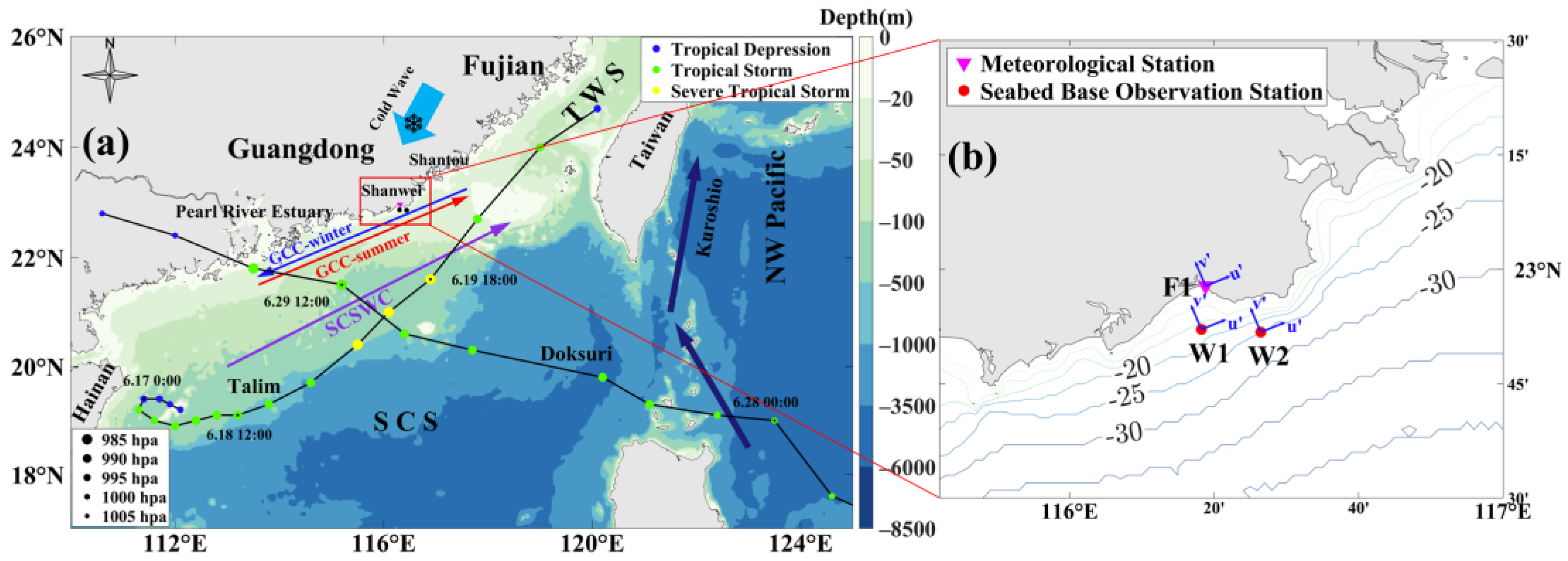




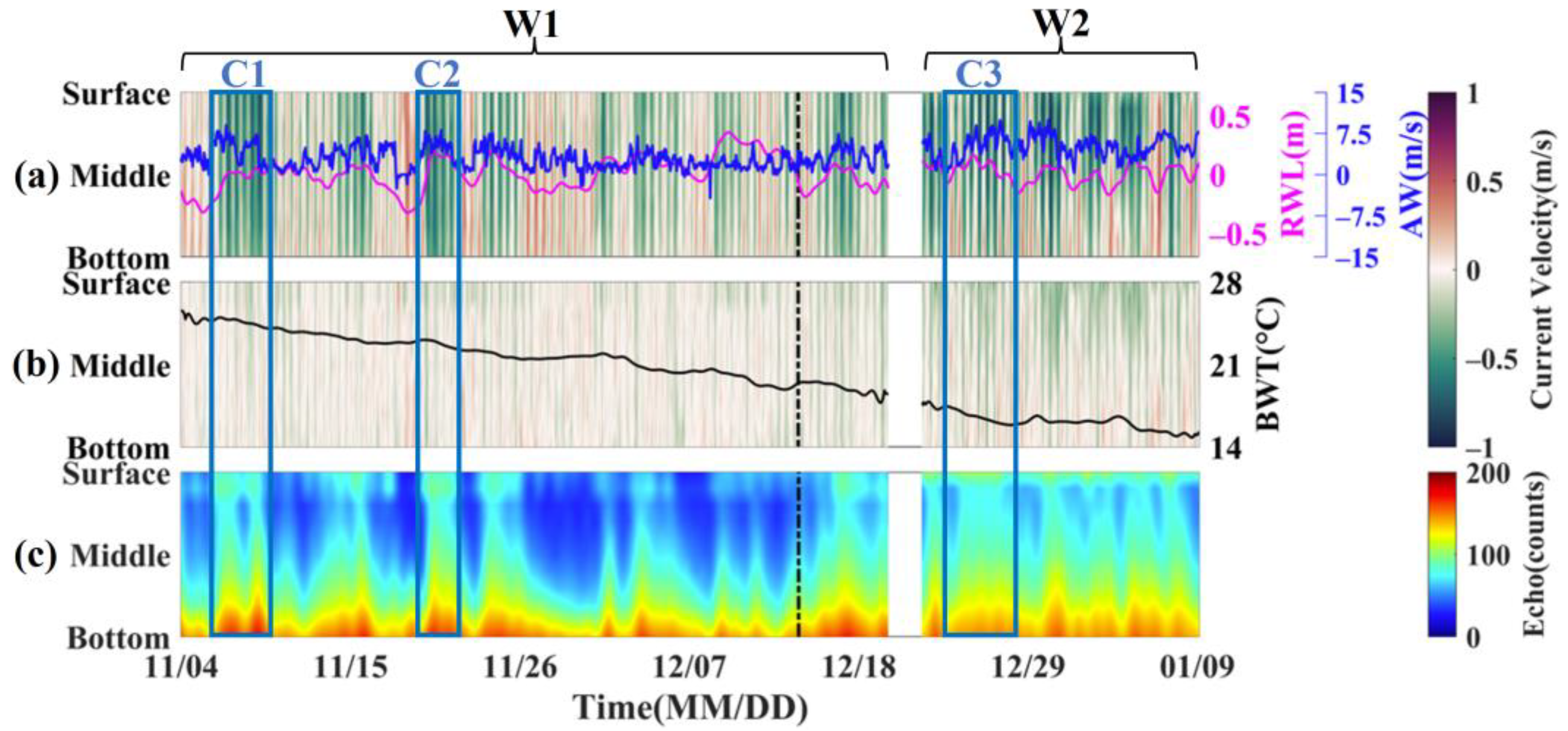
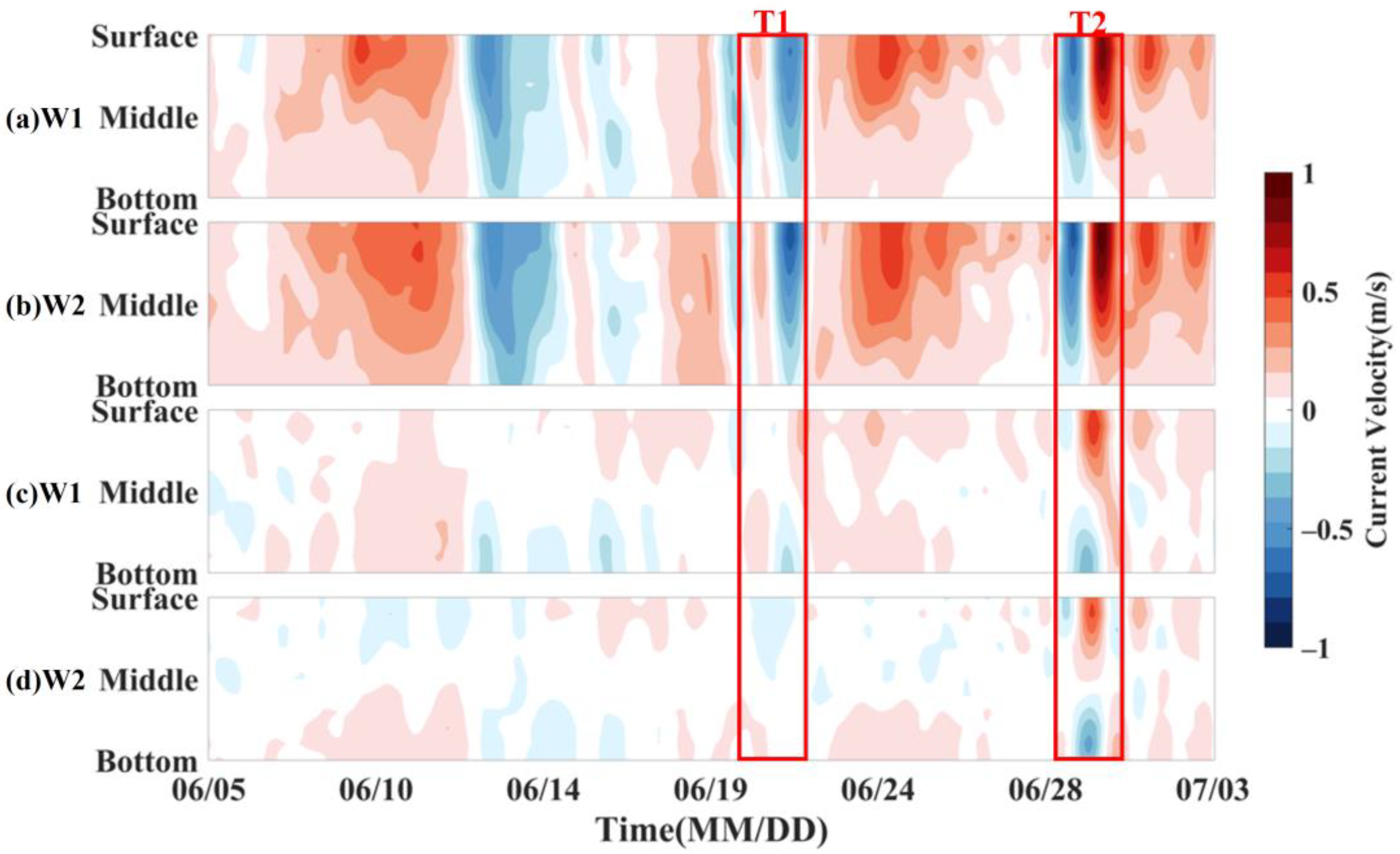

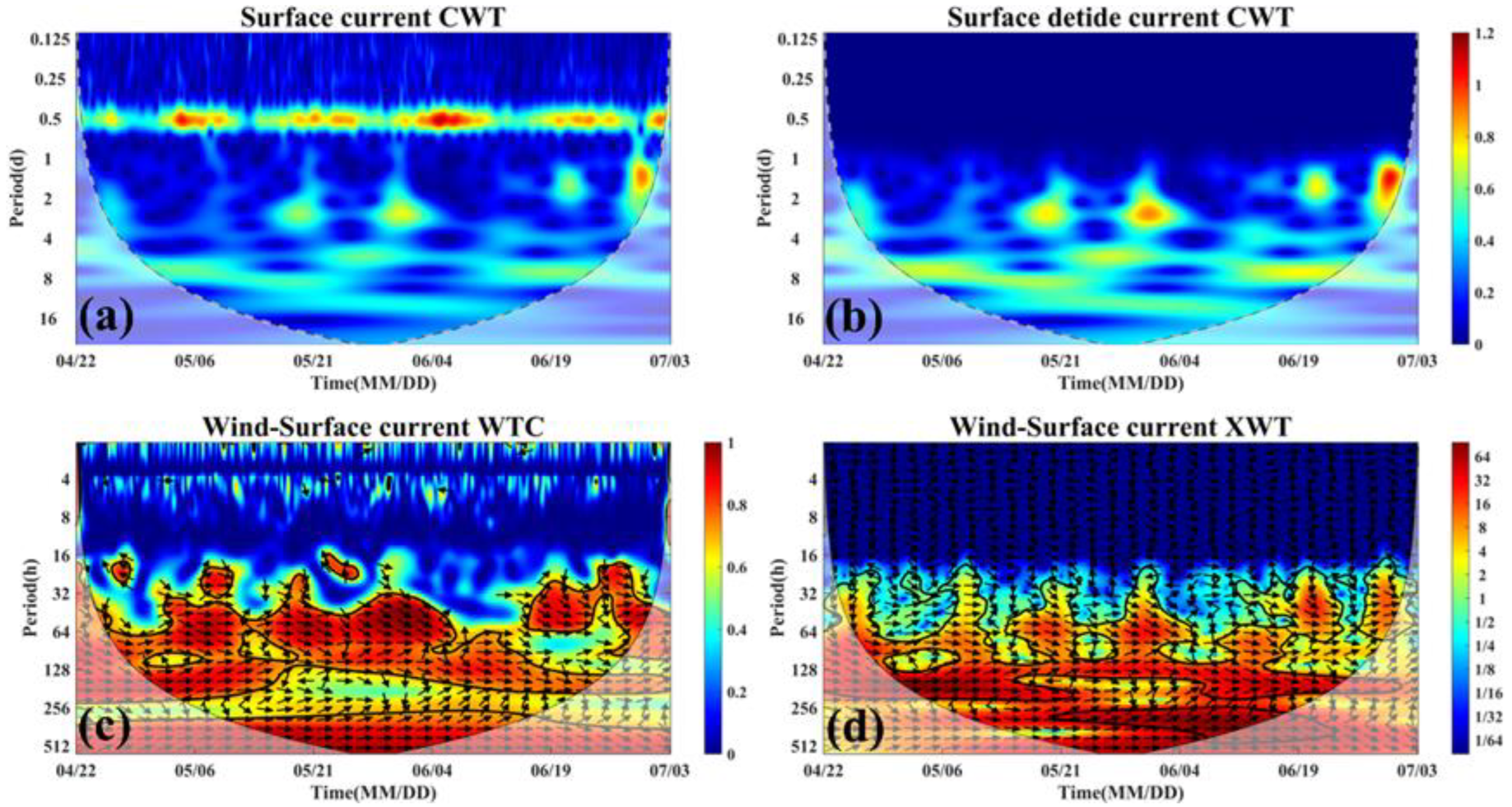
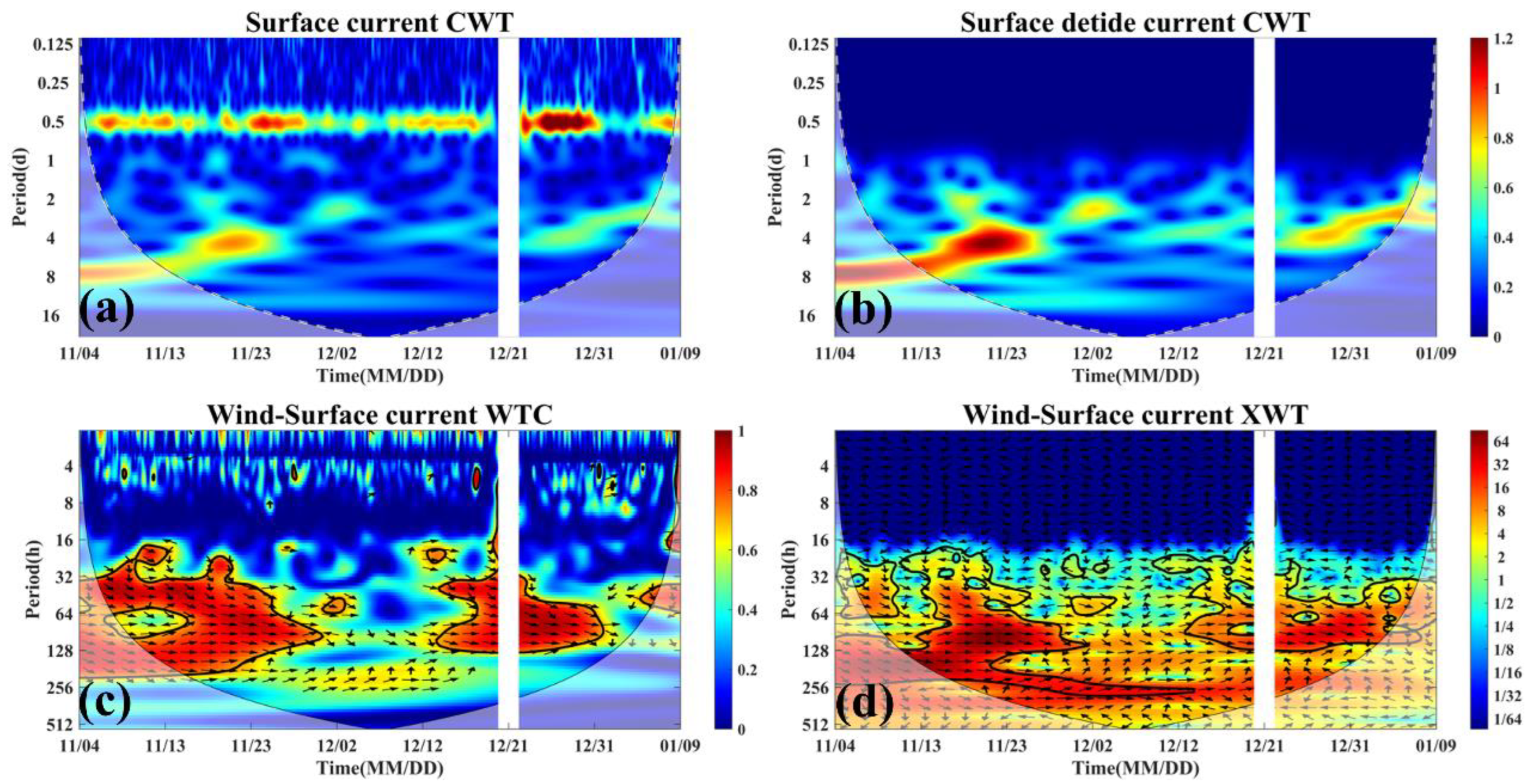
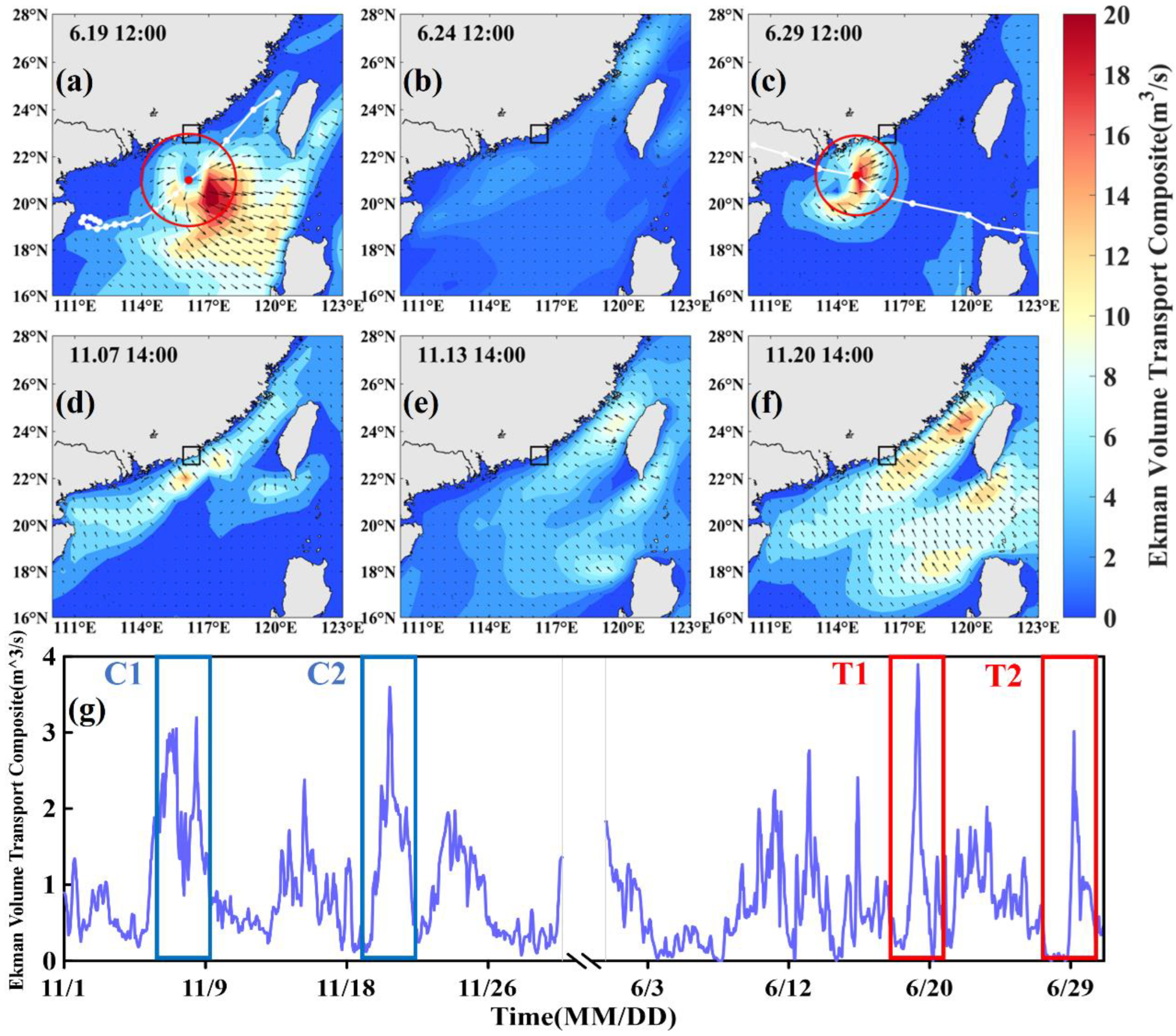
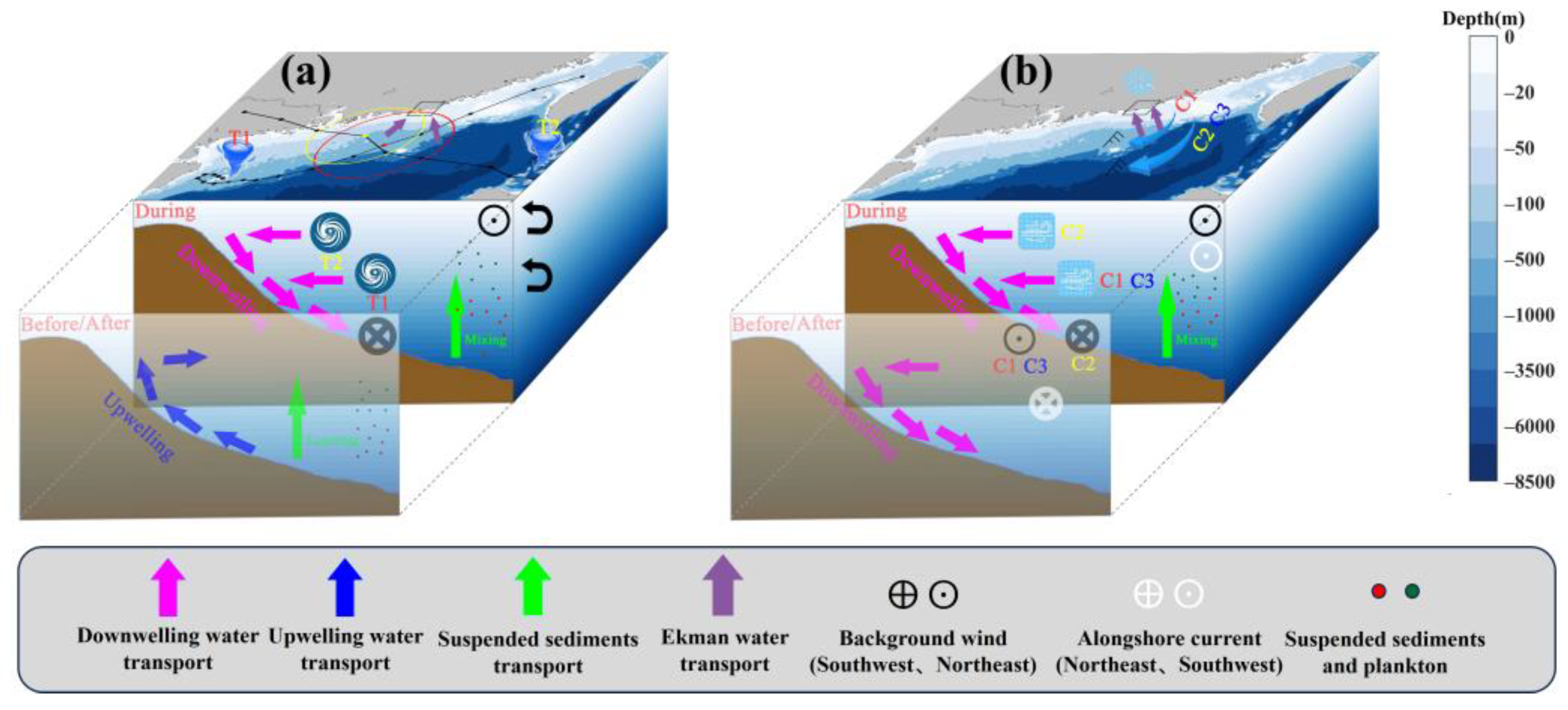
| Event | Name | Duration (YYYY.MM.DD HH) | Max Wind Speed (m/s) | Min Central Pressure (hPa) |
|---|---|---|---|---|
| TC | T1 | 2012.06.17 20–2012.06.19 05 | 25 | 985 |
| T2 | 2012.06.26 08–2012.06.30 06 | 23 | 985 | |
| CW | C1 | 2011.11.06 07–2011.11.09 23 | 8.2 | - |
| C2 | 2011.11.19 15–2011.11.22 00 | 10.8 | - | |
| C3 | 2011.12.24 22–2011.12.27 16 | 11.2 | - |
| Data | Event | Main Wind Direction | Average Wind Speed (m/s) | Main Current Direction | Average Current Velocity (m/s) |
|---|---|---|---|---|---|
| Reanalysis Data 1 | T1 | NNE | 3.08 | SSW | 0.26 |
| C1 | NE | 7.13 | WSW | 0.31 | |
| Measured Data 2 | T1 | NNE | 3.56 | SW | 0.27 |
| C1 | ENE | 6.66 | WSW | 0.42 |
Disclaimer/Publisher’s Note: The statements, opinions and data contained in all publications are solely those of the individual author(s) and contributor(s) and not of MDPI and/or the editor(s). MDPI and/or the editor(s) disclaim responsibility for any injury to people or property resulting from any ideas, methods, instructions or products referred to in the content. |
© 2024 by the authors. Licensee MDPI, Basel, Switzerland. This article is an open access article distributed under the terms and conditions of the Creative Commons Attribution (CC BY) license (https://creativecommons.org/licenses/by/4.0/).
Share and Cite
Zhong, Y.; Luo, F.; Li, Y.; Lin, Y.; He, J.; Lin, Y.; Shu, F.; Zheng, B. Influence of Tropical Cyclones and Cold Waves on the Eastern Guangdong Coastal Hydrodynamics: Processes and Mechanisms. J. Mar. Sci. Eng. 2024, 12, 2148. https://doi.org/10.3390/jmse12122148
Zhong Y, Luo F, Li Y, Lin Y, He J, Lin Y, Shu F, Zheng B. Influence of Tropical Cyclones and Cold Waves on the Eastern Guangdong Coastal Hydrodynamics: Processes and Mechanisms. Journal of Marine Science and Engineering. 2024; 12(12):2148. https://doi.org/10.3390/jmse12122148
Chicago/Turabian StyleZhong, Yichong, Fusheng Luo, Yunhai Li, Yunpeng Lin, Jia He, Yuting Lin, Fangfang Shu, and Binxin Zheng. 2024. "Influence of Tropical Cyclones and Cold Waves on the Eastern Guangdong Coastal Hydrodynamics: Processes and Mechanisms" Journal of Marine Science and Engineering 12, no. 12: 2148. https://doi.org/10.3390/jmse12122148
APA StyleZhong, Y., Luo, F., Li, Y., Lin, Y., He, J., Lin, Y., Shu, F., & Zheng, B. (2024). Influence of Tropical Cyclones and Cold Waves on the Eastern Guangdong Coastal Hydrodynamics: Processes and Mechanisms. Journal of Marine Science and Engineering, 12(12), 2148. https://doi.org/10.3390/jmse12122148







